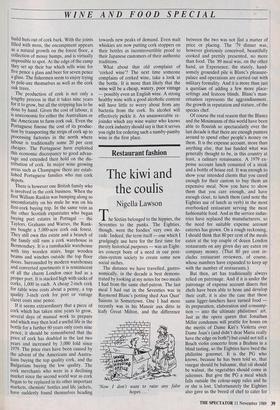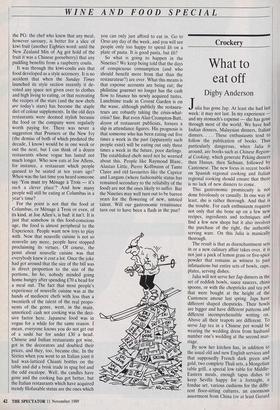Restaurant fashion
The kiwi and the coulis
Nigella Lawson
The he Sixties belonged to the hippies, the Seventies to the punks. The Eighties, though, were the foodies' very own de- cade. Indeed, the term itself— one which I grudgingly use here for the first time for purely historical purposes — was an Eight- ies concept born of a need in our post- class-system society to create some new social niches.
The distance we have travelled, gastro- nomically, in the decade is best demons- trated by looking at my notes for two meals I had from the same chef-patron. The last meal I had out in the Seventies was in Raymond Blanc's potting shed Aux Quat' Saisons in Somertown. One 1 had more recently was in his Manoir aux ditto in leafy Great Milton, and the difference Wow I don't want to raise any false hopes....' between the two was not just a matter of price or placing. The '79 dinner was, however gloriously conceived, beautifully cooked and prettily presented, no more than food. The '89 meal was, on the other hand, an Experience; the stately, hand- somely grounded pile is Blanc's pleasure- palace and operations are carried out with military formality. And it is more than just a question of adding a few more place- settings and festoon blinds. Blanc's man- orisation represents the aggrandisement, the growth in reputation and stature, of the species chef.
Of course the real reason that the Blanes and the Mosimanns of this world have been able to flourish so spectacularly over the last decade is that there are enough punters around to spend other people's money on them. It is the expense account, more than anything else, that has funded what was generally thought to be, in this country at least, a culinary renaissance. A 1979 ex- pense account lunch consisted of a steak and a bottle of house red. It was enough to show your intended clients that you cared enough for their custom to buy them an expensive meal. Now you have to show them that you care enough, and have enough clout, to lunch them (and note the Eighties use of lunch as verb) in the most overbooked restaurant serving the most fashionable food. And as the service indus- tries have replaced the manufacturers, so the need for suitable expense account eateries has grown. On a rough reckoning, I should think that 80 per cent of the meals eaten at the top couple of dozen London restaurants on any given day are eaten on company money. (That 80 per cent in- cludes restaurant reviewers, of course, whose numbers have expanded to keep up with the number of restaurants.)
But then, art has traditionally always relied on patronage. And if it is under the patronage of expense account diners that chefs have been able to hone and develop their craft, it is also the case that these same ligger-lunchers have turned food its preparation, elaboration and consump- tion — into the ultimate philistines' art. Just as the opera queen that Jonathan Miller condemns will prattle for hours on the merits of Dame Kiri's Violetta over Dame Joan's (and didn't dear Maria really have the edge on both?) but could not tell a Bruch violin concerto from a Brahms in a blind tasting, so the Eighties have bred the philistine gourmet. It is the PG who knows, because he has been told so, that vinegar should be balsamic, that oil should be walnut, the vegetables should come in juliennes. But give the PG a meal which falls outside the colour-supp rules and he or she is lost. Unfortunately the Eighties also gave us the breed of chef to cater for
WINE AND FOOD SPECIAL
the PG: the chef who knew that any meal, however savoury, is better for a slice of kiwi fruit (another Eighties word: until the New Zealand Min of Ag got hold of the fruit it was a Chinese gooseberry) that any pudding benefits from a raspberry coulis.
It was through the kiwi-coulis axis that food developed as a style accessory. It is no accident that when the Sunday Times launched its style section recently it de- voted any space not given over to clothes and high living to eating, or that recreating the recipes of the stars (and the new chefs are today's stars) has become the staple diet of colour supplements. In the old days restaurants were deemed stylish because the food or the company were regularly worth paying for. There was never a suggestion that Pruniers or the New Ivy (the demise of both of which predated the decade, I know) would be in one week or out the next, but I can think of a dozen restaurants whose vogue has lasted not much longer. Who now eats at Joe Aliens, for instance, a restaurant which people queued to be seated at ten years ago? When was the last time you heard someone say 'You must try Ménage a Trois — it's such a clever place'? And how many people will still be eating at Columbus in a year's time?
For the point is not that the food at Columbus, or Ménage a Trois or even, of its kind, at Joe Allen's, is bad: it isn't. It is just that somehow in this food-conscious age, the food is almost peripheral to the Experience. People want new toys to play with. Now that nouvelle cuisine is not so nouvelle any more, people have stopped proclaiming its virtues. Of course, the point about nouvelle cuisine was that everybody knew it cost a lot. Once the joke had got around that the size of the bill was in direct proportion to the size of the portions, ho ho, nobody minded going home hungry after spending £70 a head for a meal out. The fact that most people's experience of nouvelle cuisine was at the hands of mediocre chefs with less than a twentieth of the talent of the real propo- nents of the genre, went, in the main, unnoticed: cash not cooking was the deci- sive factor here. Japanese food was in vogue for a while for the same reason. I mean, everyone knows you do not get out of a sushi bar for under £30 a head. Chinese and Indian restaurants got wise, got in the decorators and doubled their prices, and they, too, became chic. In the Sixties when you went to an Italian joint it had wax-latticed Chianti bottles on the table and did a brisk trade in spag bol and the odd escalope. Well, the candles have gone and the cooking has got better, but the Italian restaurants which have acquired trendy filofaxable status are the ones which you can only just afford to eat in. Go to Orso any day of the week, and you will see people only too happy to spend £6 on a plate of pasta. It is good pasta, but £6?
So what is going to happen in the Nineties? We keep being told that the days of conspicuous consumption (and who should benefit more from that than the restaurateur?) are over. What this means is that expense accounts are being cut; the philistine gourmet no longer has the cash flow to finance his newly acquired tastes. Lunchtime trade in Covent Garden is on the wane, although publicly the restaura- teurs are robustly taking the crisis-what- crisis? line. But even Alan Crompton-Batt, doyen of restaurant publicists, forsees a slip in attendance figures. His prognosis is that someone who has been eating out five times a week in the past (apparently such people exist) will be eating out only three times a week in the future, poor darlings. The established chefs need not be worried about this. People like Raymond Blanc, Alastair Little, Pierre Koffmann of Tante Claire and old favourites like the Caprice and Langans (where fashionable status has remained secondary to the reliabilty of the food) are not the ones likely to suffer. But the Nineties may well turn out to be barren years for the flowering of new, untried talent. Will our gastronomic renaissance turn out to have been a flash in the pan?











































































 Previous page
Previous page